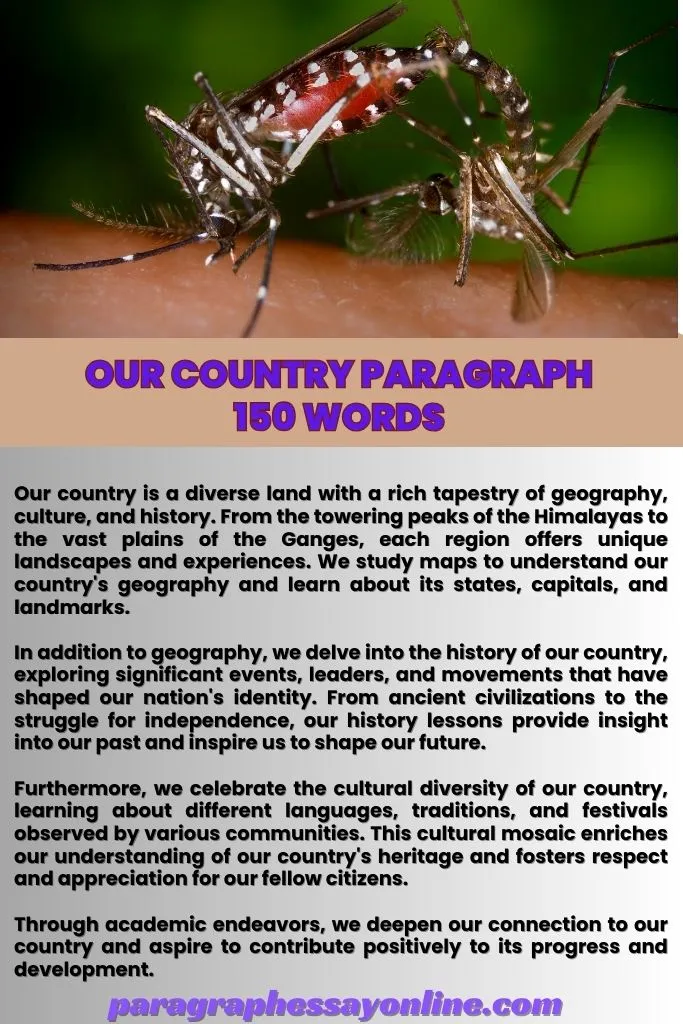Our Country Paragraph
Our Country Paragraph For All Class (100- 500 words)
Our Country encapsulates the essence of our homeland, embodying its diverse landscapes, rich history, and vibrant culture. From towering mountains to sprawling plains, and bustling cities to serene villages, our country is a tapestry of experiences waiting to be explored and celebrated.
Our Country Paragraph 100 Words For 1, 2, 3 Students
Our country is where we live, learn, and play. It has different places like mountains, rivers, and cities. We have different people, languages, and cultures. We learn about our country in school and explore its maps and flags. Our country is special, and we are proud to call it home. we learn about the history of our country, like important events and famous people. We also study its geography, like where different states and cities are located on the map. Learning about our country helps us understand its past, present, and future.

Our Country Paragraph 150 Words For 4 And 5 Students

Our Country Paragraph 200 Words For 6, 7, 8 Students
Our country is a vast and diverse land that offers a wealth of academic exploration. Geographically, it spans from the snow-capped peaks of the Himalayas to the sun-kissed beaches of the Indian Ocean. We study its geography to understand the distribution of landforms, rivers, and climate patterns, which shape our country’s landscape.
In addition to geography, we delve into the rich history of our nation, tracing back thousands of years to ancient civilizations like the Indus Valley and Maurya Empire. We learn about pivotal moments such as the Mughal era and the struggle for independence led by Mahatma Gandhi, which have shaped our country’s trajectory.
Furthermore, our academic endeavors extend to exploring the cultural mosaic that defines our country. We learn about the diverse languages, religions, and traditions practiced by various communities across India. From Diwali to Eid, we celebrate festivals that highlight our cultural heritage and promote unity in diversity.
Moreover, we analyze contemporary issues facing our country, such as environmental conservation, social inequality, and technological advancements. Through academic discourse and critical thinking, we seek to understand these challenges and contribute to positive change in our society.
Our academic journey encompasses a comprehensive study of our country’s geography, history, culture, and contemporary issues, empowering us to become informed and responsible citizens committed to the progress and prosperity of our nation.
Our Country Paragraph 250 Words For 8,9,10 Students
Our country, India, is a fascinating blend of diverse cultures, landscapes, and traditions, offering a plethora of academic endeavors for exploration. Geographically, India is characterized by its varied terrain, including the towering Himalayas in the north, the fertile plains of the Indo-Gangetic region, and the lush Western Ghats in the south. Understanding these geographical features aids in comprehending our country’s diverse ecosystems and climatic conditions.
Delving into the history of India reveals a rich tapestry of civilizations, dynasties, and empires that have left an indelible mark on our cultural heritage. From the ancient Indus Valley Civilization to the Mughal Empire and the British Raj, each era contributes to our nation’s historical narrative, offering insights into social, political, and economic developments over millennia.
India’s cultural mosaic is a testament to its unity in diversity. With over 1,600 languages spoken and a plethora of festivals celebrated across the country, India’s cultural landscape is vibrant and dynamic. Studying different languages, art forms, and traditions enhances our appreciation for the country’s multicultural ethos and fosters intercultural understanding.
Moreover, academic endeavors in India extend beyond history and culture to contemporary issues facing the nation. From environmental conservation and sustainable development to social justice and technological innovation, students engage in critical analysis and problem-solving to address pressing challenges confronting society.
In conclusion, our academic journey in understanding our country encompasses a multidisciplinary approach, including geography, history, culture, and contemporary issues. Through rigorous study and inquiry, students develop a holistic understanding of India’s past, present, and future, empowering them to contribute meaningfully to its progress and development.
Our Country Paragraph 300 Words For 9, 10, 11, 12 Students
Our country, is a vibrant tapestry of culture, history, and diversity, offering a multitude of academic avenues for exploration. Geographically, India’s landscape encompasses diverse terrains, including the majestic Himalayas in the north, the fertile plains of the Indo-Gangetic region, and the picturesque coastline along the Arabian Sea and Bay of Bengal. Understanding the geographical features of India provides insights into its unique ecosystems, climate patterns, and natural resources.
Furthermore, delving into India’s rich history unveils a captivating narrative spanning millennia. From the ancient civilizations of the Indus Valley and Vedic period to the medieval dynasties of the Mauryas, Guptas, and Mughals, and the colonial legacy of the British Raj, each epoch contributes to India’s cultural heritage and societal evolution. Exploring historical events, personalities, and movements enables students to comprehend the complexities of India’s past and its enduring impact on the present.
Moreover, India’s cultural diversity is a hallmark of its identity, with a kaleidoscope of languages, religions, and traditions interwoven into its social fabric. Studying the myriad cultural expressions, from classical dance forms like Bharatanatyam and Kathak to religious festivals such as Diwali and Eid, fosters an appreciation for India’s pluralistic ethos and promotes cross-cultural understanding.
Additionally, academic endeavors in India extend to contemporary issues that shape the nation’s trajectory. From sustainable development and environmental conservation to social justice and technological innovation, students engage in critical inquiry and analysis to address pressing challenges facing Indian society. By exploring these interdisciplinary topics, students develop a comprehensive understanding of India’s past, present, and future, equipping them with the knowledge and skills to contribute meaningfully to the nation’s progress and development.
In essence, our academic journey in understanding our country encompasses a holistic approach that integrates geography, history, culture, and contemporary issues. Through rigorous study and scholarly inquiry, students emerge as informed citizens poised to navigate the complexities of India’s dynamic landscape and contribute positively to its growth and prosperity.
Paragraph On Our Country 500 Words For 9, 10, 11, 12 Students
Our beloved country, is a treasure trove of diversity, history, and culture, offering a plethora of academic pursuits for students to explore and understand comprehensively. Geographically, India boasts a varied landscape that includes the towering Himalayas in the north, the arid deserts of Rajasthan, the lush Western Ghats in the south, and the fertile plains of the Indo-Gangetic region. Studying the geography of India provides insights into its diverse ecosystems, climate patterns, and natural resources, crucial for sustainable development and environmental conservation efforts.
Delving into India’s rich history reveals a captivating narrative that spans several millennia, encompassing ancient civilizations, medieval dynasties, and colonial rule. From the sophisticated urban planning of the Indus Valley Civilization to the intellectual advancements of the Gupta Empire and the cultural synthesis of the Mughal era, each period contributes to India’s cultural heritage and societal evolution. Exploring historical events, significant personalities, and socio-political movements enables students to comprehend the complexities of India’s past and its enduring impact on the present.
Moreover, India’s cultural landscape is a mosaic of languages, religions, and traditions, reflecting its pluralistic ethos and unity in diversity. With over 1,600 languages spoken and a myriad of festivals celebrated across the country, India’s cultural tapestry is vibrant and dynamic. Studying different languages, classical art forms, and religious practices fosters an appreciation for India’s rich heritage and promotes intercultural understanding among its diverse populace.
Additionally, academic pursuits in India extend beyond history and culture to contemporary issues that shape the nation’s trajectory in the 21st century. From sustainable development and social justice to technological innovation and geopolitical challenges, students engage in critical inquiry and analysis to address pressing concerns facing Indian society. By exploring interdisciplinary topics and adopting a holistic approach, students develop a comprehensive understanding of India’s past, present, and future, equipping them with the knowledge and skills to navigate the complexities of the modern world and contribute meaningfully to the nation’s progress and development.
academic exploration in India extends to analyzing contemporary issues that shape the nation’s trajectory in the 21st century. From environmental sustainability and social justice to technological innovation and geopolitical challenges, students engage in critical inquiry and analysis to address pressing concerns facing Indian society. By delving into these interdisciplinary topics, students develop a nuanced understanding of India’s present challenges and opportunities, equipping them with the knowledge and skills to navigate the complexities of the modern world.
Through scholarly inquiry and active participation in academic endeavors, students contribute to shaping India’s future, fostering progress, and upholding the values of democracy, diversity, and inclusivity. In essence, the academic journey of understanding our country encompasses a multifaceted approach that empowers students to become informed and responsible citizens capable of driving positive change and contributing to the nation’s growth and development.
In essence, our academic journey in understanding our country encompasses a multidisciplinary approach that integrates geography, history, culture, and contemporary issues. Through rigorous study, scholarly inquiry, and critical thinking, students emerge as informed citizens ready to embrace the challenges and opportunities of a dynamic and diverse India, fostering unity, prosperity, and progress for generations to come.
Most Important Paragraph:
| My Reading Room Paragraph. |
| Paragraph On University. |
| My Daily Routine Paragraph. |
| Ishwar Chandra Vidyasagar Paragraph. |
| A Moonlit Night Paragraph. |
Frequently Asked Questions For Our Country Paragraph
1. What is the significance of studying our country’s geography?
Answer: Understanding our country’s geography helps us grasp its diverse landscapes, climate patterns, and natural resources, which are essential for sustainable development and environmental conservation.
2. Why is it important to learn about India’s history?
Answer: Studying India’s history provides insights into its cultural heritage, societal evolution, and the factors that have shaped its identity over millennia.
3. How does India’s cultural diversity contribute to its uniqueness?
Answer: India’s cultural diversity, manifested in its languages, religions, and traditions, enriches its social fabric and promotes unity in diversity.
4. What contemporary issues are addressed through academic endeavors in India?
Answer: Academic pursuits in India encompass analyzing contemporary issues such as environmental sustainability, social justice, technological innovation, and geopolitical challenges.
5. How do academic endeavors empower students to contribute to India’s progress?
Answer: By engaging in critical inquiry and analysis, students develop the knowledge, skills, and perspectives needed to navigate the complexities of modern India and contribute positively to its growth and development.
